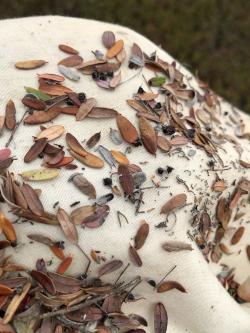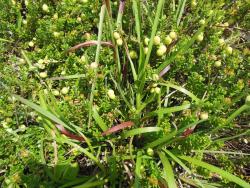News from the Entomology Lab, News from the Weed/IPM Lab, Preliminary Keeping Quality Forecast, and Station News
Our website is currently going through some updates. To request a hard copy of the May 3, 2024 Cranberry Station Newsletter please email Robyn Hardy at rmhardy@umass.edu.
CRANBERRY STATION NEWSLETTER
News from the Entomology Lab
By Anne Averill and Marty Sylvia
INSECT CLINICS
Be Informed! Insect Clinics are scheduled for:
Wednesday, May 22, 2024, and Wednesday, May 29, 2024
8:00-10:00 AM
UMass Cranberry Station
(AD Makepeace Meeting Room and Entomology Lab)
Training to identify and manage the new problematic insects. Introductory discussion followed by hands on lab ID with samples from the bog (Cranberry Black Bug, Blunt-nosed leafhopper, Vaccinium Scale, Collembola). Both sessions are being held in-person (2 credits each meeting) and it's FREE to participate. To sign up please contact Marty Sylvia martys@umass.edu or 508-265-6921.
WPS TRAINING FOR HANDLERS
Anyone working on the cranberry bogs (bogs that have been treated within 30 days) who does not have a Massachusetts Pesticide Certification needs to have worker protection training each year. I am offering a few dates on ZOOM that your workers could attend to cover this requirement. Training dates are:
Friday May 17, 2024, 7:30-9:00 AM
Wednesday, June 5, 2024, 7:30-9:00 AM
Cost is $5 per person. This will be a handler training and will allow workers to help apply general use pesticide and Roundup (glyphosate) or spot treat with Intensity or Stinger. This training can be done with each person on a smartphone or computer, or in a group setting around a screen – but I need verification of each person attending. Paperwork will be completed that can cover EPA WPS requirements.
To attend a training or for more information please contact Marty Sylvia martys@umass.edu or 508-265-6921.
News from the Weed/IPM Lab
By Katie Ghantous and Hilary Sandler
GETTING GOOD GRASS CONTROL WITH HERBICIDES
We have been getting lots of questions about correct timing for managing grasses in cranberry beds. The answer is – it depends on what you are managing!
There are two herbicides that are registered for grass control in cranberry. The two active ingredients sethoxydim (Poast) and clethodim (Select, SelectMax, Intensity, IntensityOne, etc.) are similar to each other.
These herbicides are ACCase inhibitors. They injure grasses by interfering with an enzyme that grass plants need to make cell membranes. They work best when grasses are actively growing – in the process of adding new cells and increasing in size. So, while some grasses may remain green through the winter (like the center of a poverty grass tussock), which shows the grass is living, it is not in a state of active growth. Simply being green/alive is not a good indicator for when to use these herbicides.
There are many different species of grasses found as weeds on cranberry beds. Some are “cool-season grasses” while others are “warm-season grasses”. Cool-season grasses do most of their active growth in cooler temperatures in the spring and early fall. If the grass you are trying to manage falls into that category, you would time your herbicide treatment for those windows. Warm-seasons grasses (including both species of poverty grass) prefer the warmer soil and air temperatures of summer. For poverty grass, we do not see them bulking up until mid-to late-July.
There are a few other important things to know about these herbicides. They ONLY work on grasses, and not on other plants that look like grasses. Even if you do not know the exact species you are trying to manage, you need to make sure it is really a true grass before attempting to control it with one of the grass herbicides. Some sedges and rushes look very grass-like, but these herbicides will not work on sedges or rushes. Some common names can really add to the confusion. For example, “Woolgrass” is a sedge and “Broomsedge” is a grass.
These herbicides work best on actively growing grasses BEFORE they make flowers/seed. If you wait until you see poverty grass sending up the tall seed stems, it is too late for good efficacy. And lastly, these herbicides need adjuvant to work well. All of the labels call for NIS or crop oil to be included. Read the label to determine the proper adjuvant for the product you are using. They have little to no soil activity and can only enter the plant through the leaves. Avoid run-off to keep as much material on the grass leaves as possible. ONLY IntensityOne can be applied through the chemigation system (SLN label for MA).
To get good grass control, think of it as managing two problems: the seeds to make new grass plants, and the grass plants that are already there. While it may be too early for managing existing grass plants with herbicides, preemergence herbicides like Devrinol can prevent new plants from establishing by inhibiting seedlings. If you have grasses on your bed, there is a good chance that there are lots of seeds out there that can make your problem worse! Tussock forming grasses (grow in clumps) like poverty grass are also good candidates for hand weeding. Our research showed that plants will not regrow from root fragments left behind as long as you get the crown out. Hand weeding poverty grass can be effective at any time of year.
- Confirm that your target plant is actually a GRASS.
- Choose a grass herbicide and add an adjuvant.
- Time the application for ACTIVE growth.
- Apply BEFORE flowers appear.
- Use a 2-prong approach: Reduce seedling emergence and reduce established plant growth.
IPM MESSAGE
The first IPM Message will be posted on Friday, May 10, 2024, and will be updated each Friday until late July-early August. The best way to get all the information and see relevant photos for the 2024 season is to visit the home page of our website https://ag.umass.edu/cranberry. Click on “IPM Messages” on the right-hand side under Quick Links. There you will find the current IPM message, and you can search and view past IPM messages. You can also listen to the weekly message by calling 617-928-4000, available 24/7. Please contact Katie Ghantous kghantou@umass.edu or 508-970-7634 if you have any questions, concerns, or information to convey for the message.
Preliminary Keeping Quality Forecast
By Leela Uppala and Peter Jeranyama
The forecast is for VERY POOR preliminary keeping quality.
As of April 1, there are “0” points out of a possible “10” towards preliminary keeping quality for the 2024 Massachusetts cranberry crop. Unless the final keeping quality forecast (issued after June 1) improves in June, we do NOT recommend reducing the number and rates of fruit rot fungicide applications. Closer attention should be paid where fruit rot has been a major or regular concern. As for the holding of late water, this would be a good year to hold late water. However, growers should determine whether to hold late water based on bed conditions. Please check the table below and the section on late water in the Chart Book for advice regarding the implementation of this cultural practice. If you have any questions, please contact Leela Uppala suppala@umass.edu or 508-970-7644.
|
Late Water is advised:
|
|
Late Water is not advised:
|
Cranberry Station News
By Hilary Sandler
DIRECTOR FAREWELL
I wanted to take this occasion to thank you for the opportunity to serve you. My last date of University service is May 10, 2024. I have been so lucky to have worked with the MA Cranberry Industry and many of you personally over my 34-year career. It has been my honor to address many of your weed management concerns through research and extension efforts. I have many wonderful memories that I will carry with me always. I know that I will keep in touch with some of you as I start this new chapter of my life and I find comfort in that.
I know that I leave you in good hands. The Station is at an exciting point in time. We have a great group of capable scientists who are working daily to answer your questions and to better understand the dynamics of cranberry production. We are also in the unusual position where our infrastructure actually exceeds our capacity; we have room to grow! More growth means more great science to help you produce the best crop possible. We are excited to share what we know with you and hear what you are thinking about. Please call us and come to our meetings and workshops.
Although personnel will continue to change over time, the Station will remain a vibrant and responsive resource for the industry. I recognize that COVID has changed the workplace in fundamental ways but our commitment to the MA cranberry industry remains steadfast. The cranberry industry is nothing if not resilient. As I close my chapter at the UMass Cranberry Station, it is my heartfelt hope that you will continue to be our vital partner as we strive to meet the current and future challenges facing the cranberry industry.
2024-2026 CHART BOOK
The 2024-2026 Chart Book is here! You can pick up your copy at the Cranberry Station Monday-Friday, 8:00 am – 4:00 pm or choose to have your copy mailed to you, $8 mailing fee (per book). Contact Robyn Hardy at rmhardy@umass.edu or 508-970-7635.
COFFEE CHAT
Do you want to chat about what’s happening on your bog? Have a question about a weed or a something you can’t identify? Stop by the Station on Wednesday, June 12, 2024, between 9:00-11:00 AM, grab a cup of coffee, a snack and talk with scientists and fellow growers. Bring a sample from your bog and take a look under the microscope. We are looking forward to seeing you!



